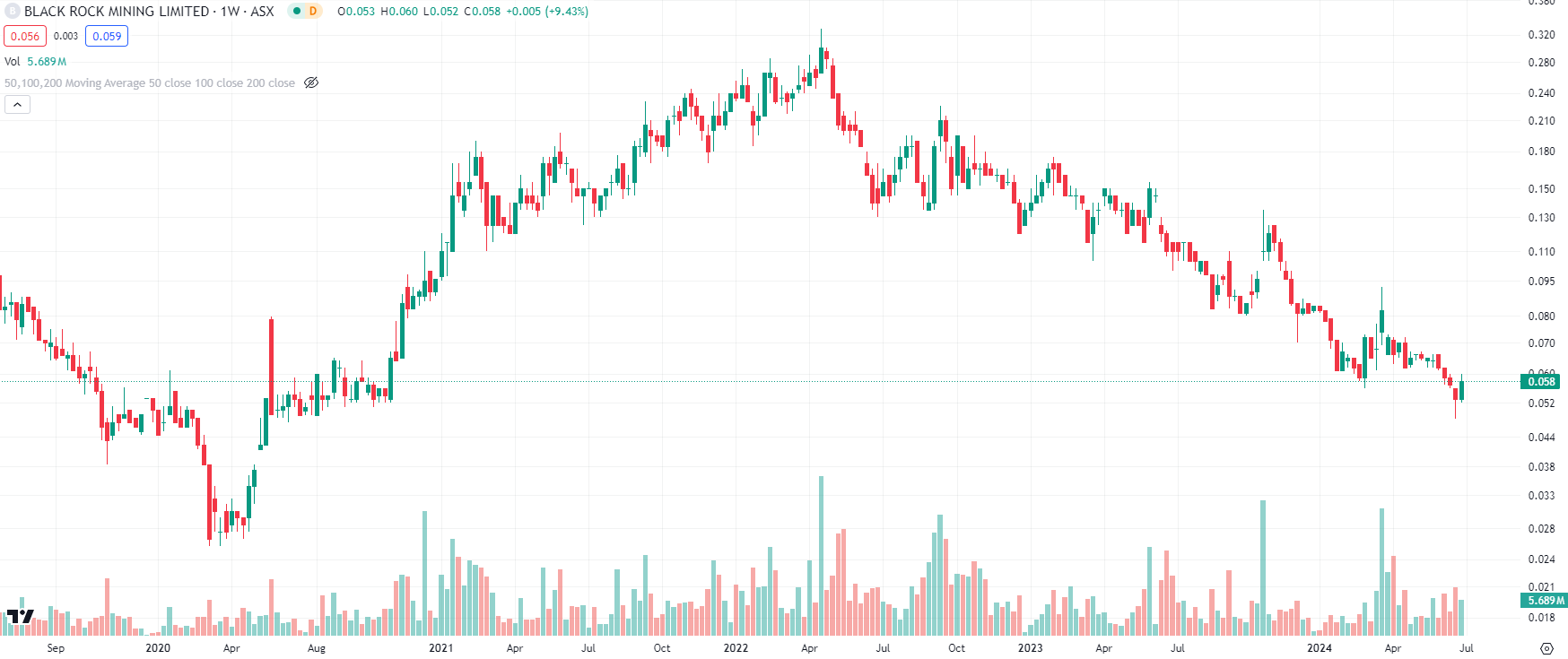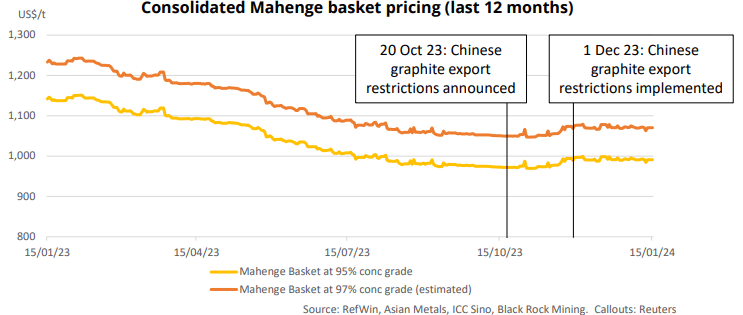Black Rock Mining (ASX:BKT): A mouth-watering graphite play in Tanzania with a US$1.4bn NPV project
![]() Nick Sundich, June 28, 2024
Nick Sundich, June 28, 2024
Black Rock Mining (ASX:BKT) is developing the Mahenge Graphite Project in Tanzania. It is hoping to capitalise on the hot demand for battery metals such as graphite, aided by Tanzania coming back into favour as a mining investment destination. But where is BKT in the race to production? It is certainly more advanced than it was before the start of this year with finance well advanced, and its full form offtake agreements secured.
Meet the Mahenge Project
Black Rock Mining’s Mahenge Project lies in the Morogoro Region of Tanzania. It has a JORC 2012 resource of 212 million tonnes at 7.8% Total Graphitic Content (TGC) and reserve of 70 million tonnes at 8.5% TGC. That reserve is so big, it’s the second largest graphite reserve in the world, while the resource makes it the fourth largest.
The Definitive Feasibility Study (DFS) has laid out the blueprint for an initial mining operation worth US$1.4bn in Net Present Value – taking into account the government’s 16% stake. This represents a 36% IRR and a 61% AISC margin.
Mahenge is spread across 324 sq km of exploration tenements in the Ulanga district. It lies ~250km from Mozambique, 250km from the coastal port city of Mtwara and 300km from Tanzania’s capital, Dar es Salaam. It has access to key infrastructure, including water, rail and grid power. The project has a 26 year initial operating life with 347,000tpa estimated in a steady production state.
Offtake agreements in place
Black Rock has offtake agreements in place with one partner being South Korea’s POSCO – which is also an 11.5% shareholder. 90% of graphite production in Module 1 is already spoken for under either a binding offtake or an option agreement. You see, Mahenge is starting up in Four Stages (or Modules). It is targeting first production from Module 1 in CY26.

The four Modules of the Mahenge Project (Source: Company)
A further two customers signed offtake deals in June 2024 – in Muhui International Trade and Qingdao Yujinxi New Material. These cover 15ktpa of large flake concentrate each, with the option to purchase an additional 10ktpa.
What’s the big deal about graphite?
Graphite is a critically important metal for several industrial and commercial applications – including electric vehicles. Various geological traits make it an ideal metal. E.g. for electric vehicle batteries, graphite helps reduce weight, increase energy efficiency and performance, increase lifespan and reduce temperature spikes inside the motor.
Graphite can be found in pencils, lubricants, batteries and fuel cells, nuclear power plants and even motors of combustion engines. And even the graphite flakes leftover from mining can be utilized for various insulation materials, including fireproofing compounds used on buildings and walls.
Total demand for graphite is expected to grow substantially in the years ahead. Benchmark Mineral Intelligence (BMI) expects demand to grow sevenfold between now and 2035. That may seem like a long time away, but the market has just entered a supply deficit and the deficit will continue to grow given the lack of new mines coming online.
Mahenge sounds good, so why has Black Rock Mining lagged?
Black Rock Mining shares have failed to reach the highs achieved in April 2022. Why is this? We put it down to three reasons. First, perceived sovereign risk. Second, graphite prices. And third, funding requirements.

Black Rock Mining (ASX:BKT) share price chart, log scale (Source: Trading View)
Sovereign risk issues are gone (but not forgotten)
In 2017, then President John Magufuli suddenly introduced radical changes to the mining code that shocked investors. These included a forced renegotiation of existing agreements between resources companies and the government, the restriction of repatriation of funds derived from mining activities and increased royalty rates and government shareholding in mineral rights holders.
These measures resulted in a deterioration in the ease of doing business and a big sell off in the shares of ASX explorers with projects in Tanzania.
Magufuli passed away in 2020 and was replaced current President Samia Suluhu Hassan in March 2021. This new administration appears to be more mining-friendly – with a stated aim of boosting the mining sector’s contribution to at least 10% of GDP by 2025. In December 2021, an agreement was signed between the Tanzanian government and four mining companies (including Black Rock Mining) for the formation of joint ventures, re-establishing investors’ confidence in the sector.
Investors still a little bit on edge
So, why then are investors still nervous about Tanzania? We see two reasons. Firstly, one of Magufuli’s measures that was maintained was a mandated 16% holding for the government. Secondly, investors are nervous that new measures could suddenly be implemented without warning.
Black Rock Mining it has been granted a Special Mining Licence (SML), has hosted site visits for the government and signed a deal with the government for the government’s 16% stake.
Graphite price volatility
The second issue is that graphite prices have had a difficult 18 months, just like other battery metals. Investors don’t know when prices will rebound, but they do know that lower prices mean lower margins. With BKT’s project, however, its AISC is US$518/t, so the margins are still very healthy.
One thing that will impact the market and BKT will be the Chinese graphite export ban. This is not an explicit ban on all graphite exports, but rather Beijing will pick and choose which companies can export to the US. This will help graphite prices, yet not otherwise restrict BKT given its major export partner POSCO is Korean.

Source: Company
Funding
The third issue is that Mahenge isn’t going to come cheap. Module 1 alone costs US$225m in capital expenditure and by the time the operators have built module 4 the total bill will run to US$553m. Also keep in mind that graphite developers have the cards stacked against them because it is harder for lenders to hedge graphite.
Ultimately, the majority of project funding for Module 1 was secured after a long wait. BKT now has US$153m in place from 3 separate lenders – Development Bank of Southern Africa (DBSA), Industrial Development Corporation of South Africa (IDC) and CRDB Bank from Tanzania. POSCO has committed to providing a further US$50m to fund development – US$40m of which would be in return for an equity investment, with the balance as a prepayment for future offtake.
In our view, the issue of funding should never have been as big of an issue as it is for investors. Yes, more funding in place will be needed for modules 2, 3 and 4, but it could be funded from free cash flow.
Keep an eye on Black Rock Mining
Black Rock Mining shareholders have a lot to look forward to in the coming months and years. The most important of these will be Mahenge entering production. Other potential catalysts could be the possible sale of a stake in its project to a partner, as well as then POSCO pushes the button on its commitment to chip in US$40m into the company.
Our parent company Pitt Street Research valued Black Rock Mining at A$0.88-$1.14 per share in August 2022 and reiterated that in May 2023 – see the reports here. This took into account free cash flows from the entire life of the project.
We believe there is strong potential for Black Rock Mining to play its part in satisfying the world’s demand for graphite! So much so, that Stocks Down Under/Pitt Street Research directors own shares in BKT.
Disclosure: Stocks Down Under/Pitt Street Research directors own shares in Black Rock Mining.
What are the Best ASX Resources stocks to invest in right now?
Check our buy/sell tips
Blog Categories
Get Our Top 5 ASX Stocks for FY25
Recent Posts
Trump vs. Jerome Powell: What Happens to the Market If Powell Is Fired?
The relationship between President Donald Trump and Federal Reserve Chair Jerome Powell has often been tumultuous, particularly around decisions regarding…
Telix Pharmaceuticals (ASX:TLX): It’s made ~A$1.7bn in revenue from Illucix, but here’s why the best is yet to come!
What would you have thought if you were told 5 years ago you would see Telix Pharmaceuticals as a successful…
Anti Woke ETFs: Do they practice what they preach and have they outperformed since Trump’s return to power?
Have you ever heard of so-called ‘Anti Woke ETFs’? If you’re sick of companies that are big on ESG, this…



